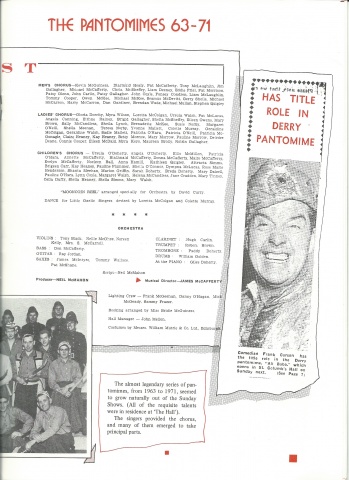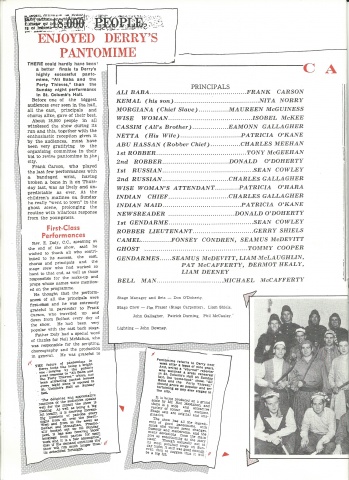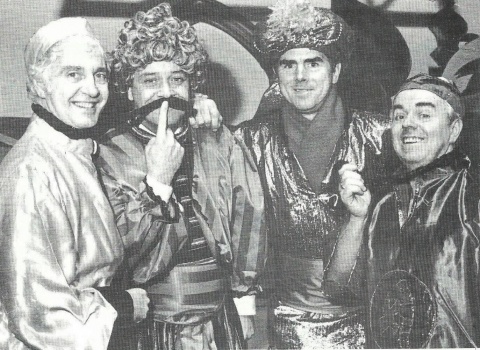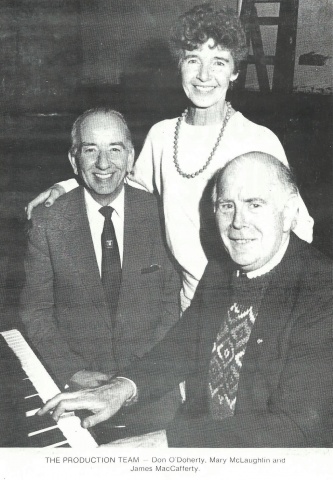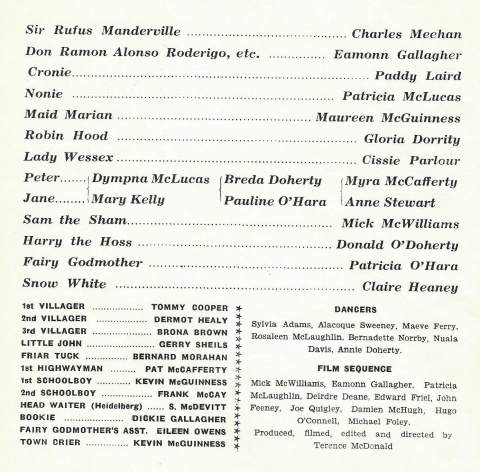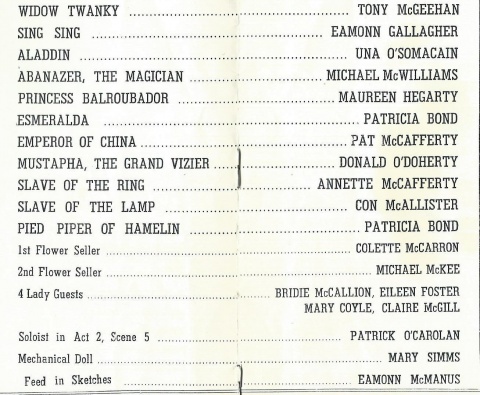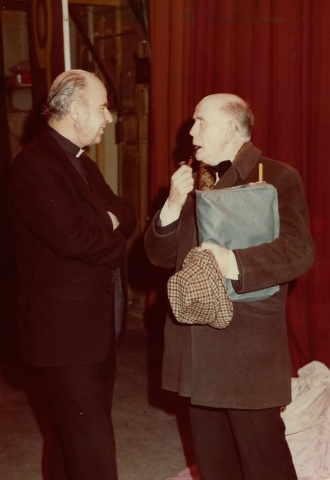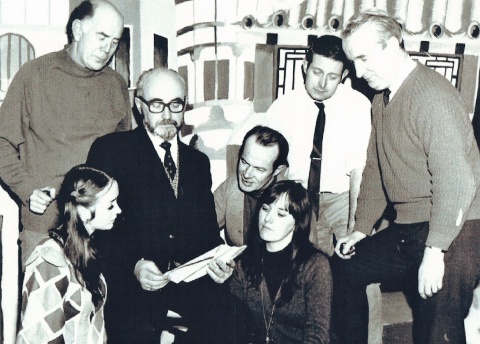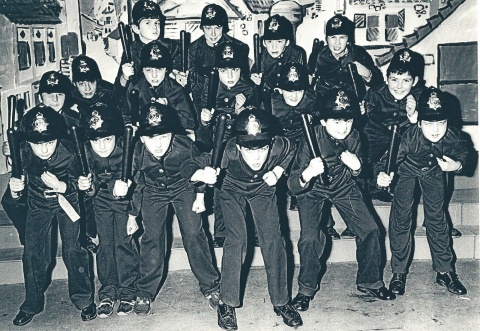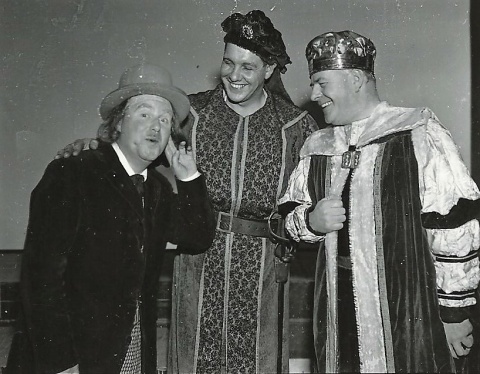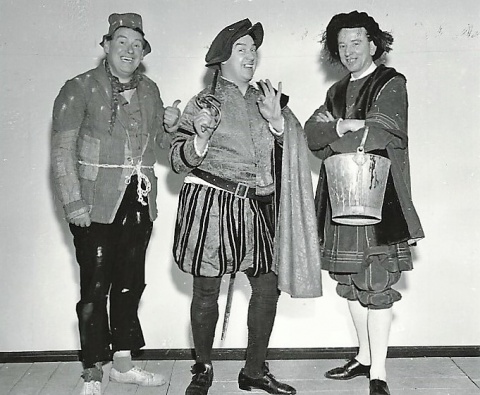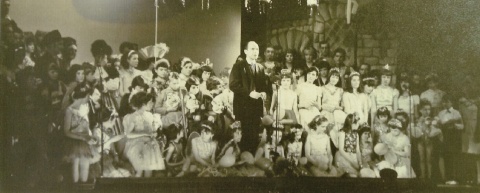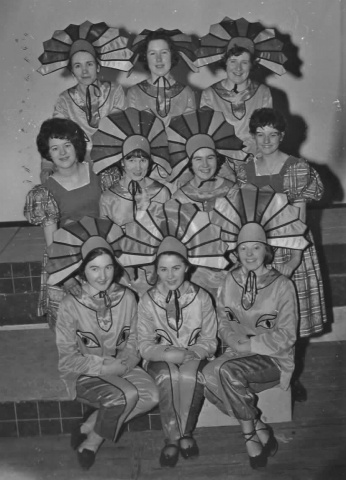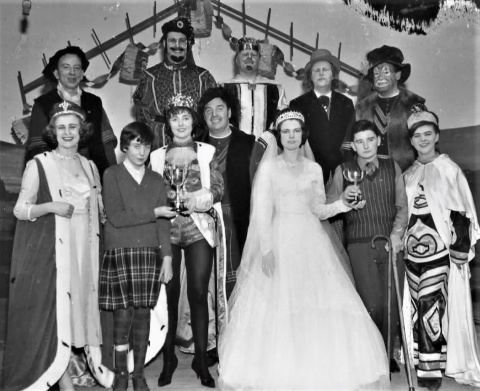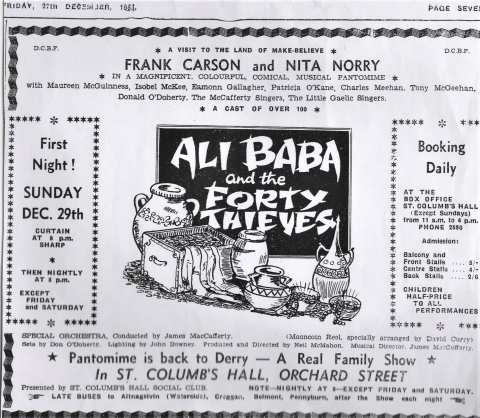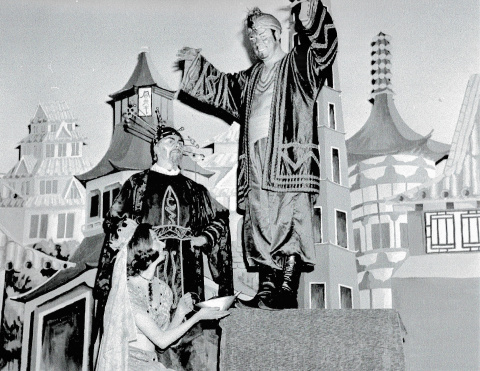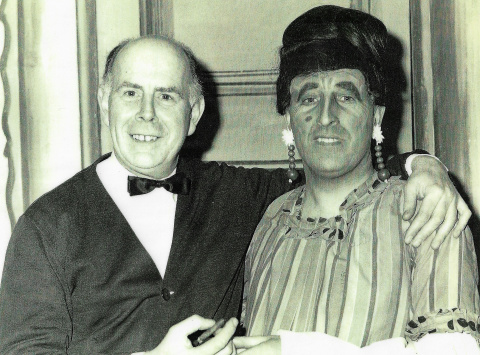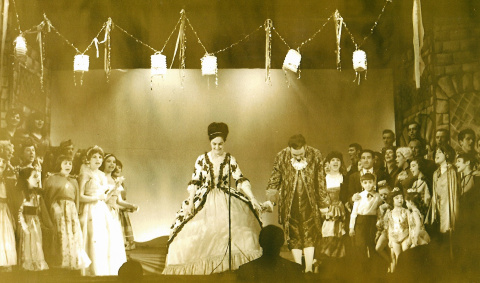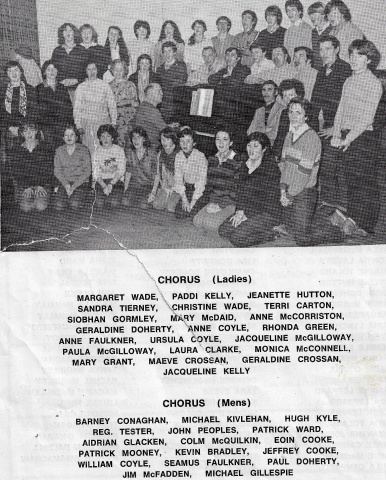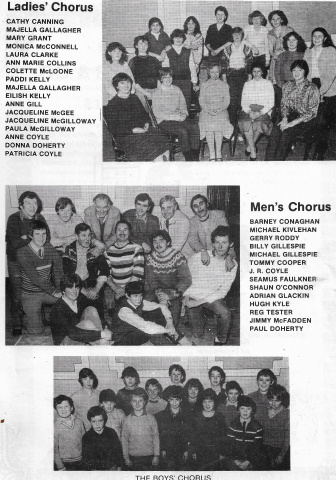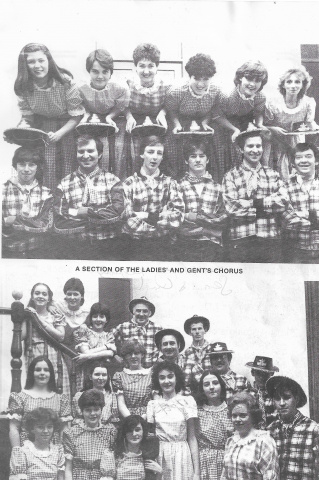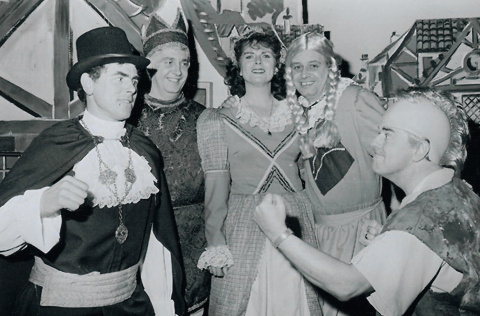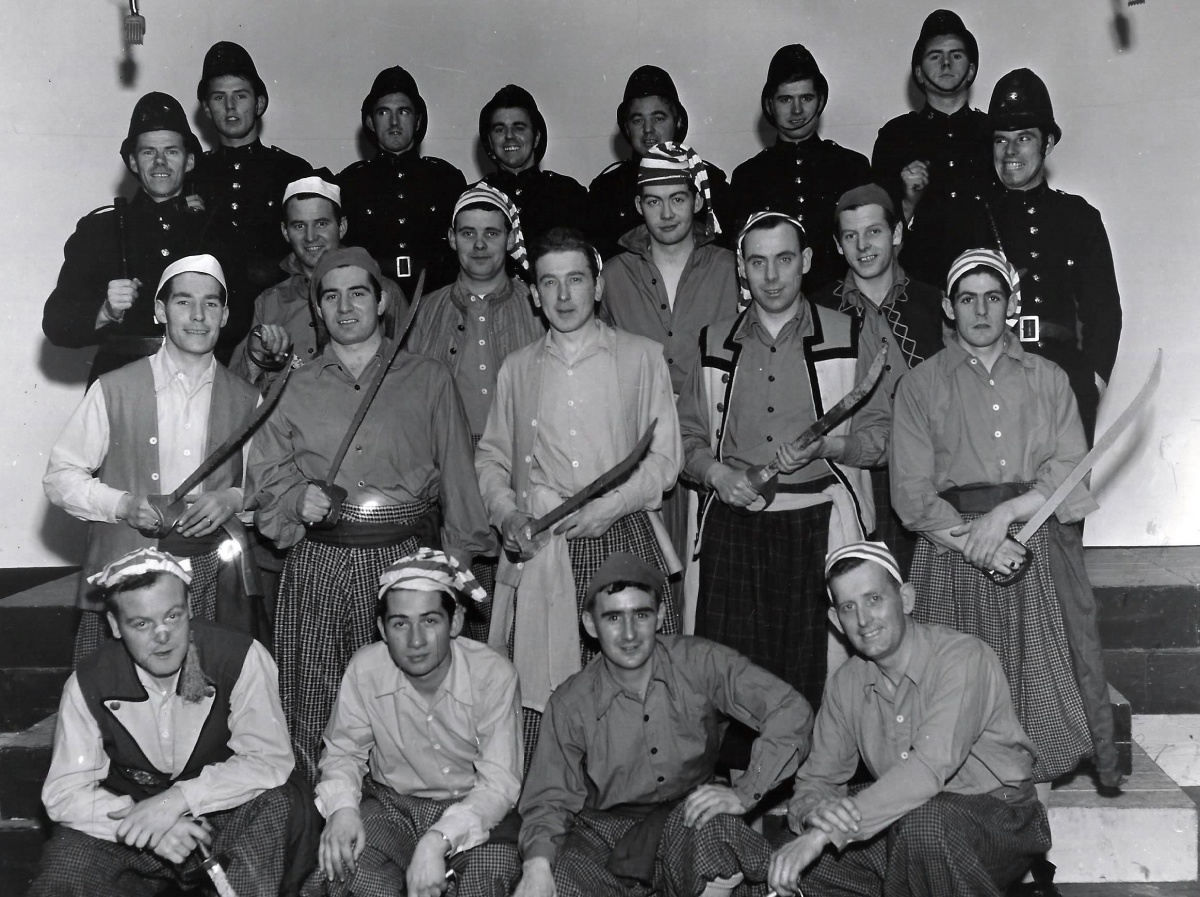
(the male chorus of Ali Baba 1963)
When Fr. Daly decided to try his hand at presenting a pantomime in St. Columb's Hall in 1963, it seemed a natural development from the hugely successful run of Sunday Night Shows. He had, after all, his comic lead in Frank Carson and he had his musical director in James, together with his resident chorus in The Mac Cafferty Singers. Many of these were to take principal roles. He soon recruited as producer Neil Mc Mahon who wrote the script and was to teach some basic dance routines to the singers. James and Neil had recently cooperated on an operetta in Moville and were very comfortable with this renewed partnership. The panto which they decided on was Ali Baba and the Forty Thieves. Funnily enough, it had been staged last in The Hall in 1945 when the legendary comedy trio of Collins, Cowley and O'Donnell had dominated the local scene. There was to be, for this single occasion, one other professional recruit - Nita Norry from Strabane - who was to take the principal boy's role.
The usual business of rehearsals began in the autumn, by which time the remaining supporting roles had been filled by other local personalities. James went about arranging an attractive selection of music for the principals and choruses. There was to be an ever-popular children's chorus as well as the ladies' and men's. Soon it was time for James to call his orchestra together, and again many of them had played in his orchestra in Moville. Most of the instrumental arrangements were, likewise, done by James. The show opened on Sunday the 29th December and played to full houses throughout the run. On the final night Fr. Daly could tell the audience that eighteen thousand people from Derry and far beyond had seen the show. There were many reasons for this unprecedented success. Besides the huge popularity of Carson and the high quality of the musical content, Fr Daly was investing heavily in state-of-the-art lighting and sound systems. He would soon extensively refurbish The Hall so that it rivalled the top theatrical venues in Ireland. As for the performers, including the members of the chorus, he had provided experienced make-up personnel, and costuming by Mutrie of Edinburgh. The net effect was of a highly professional production.
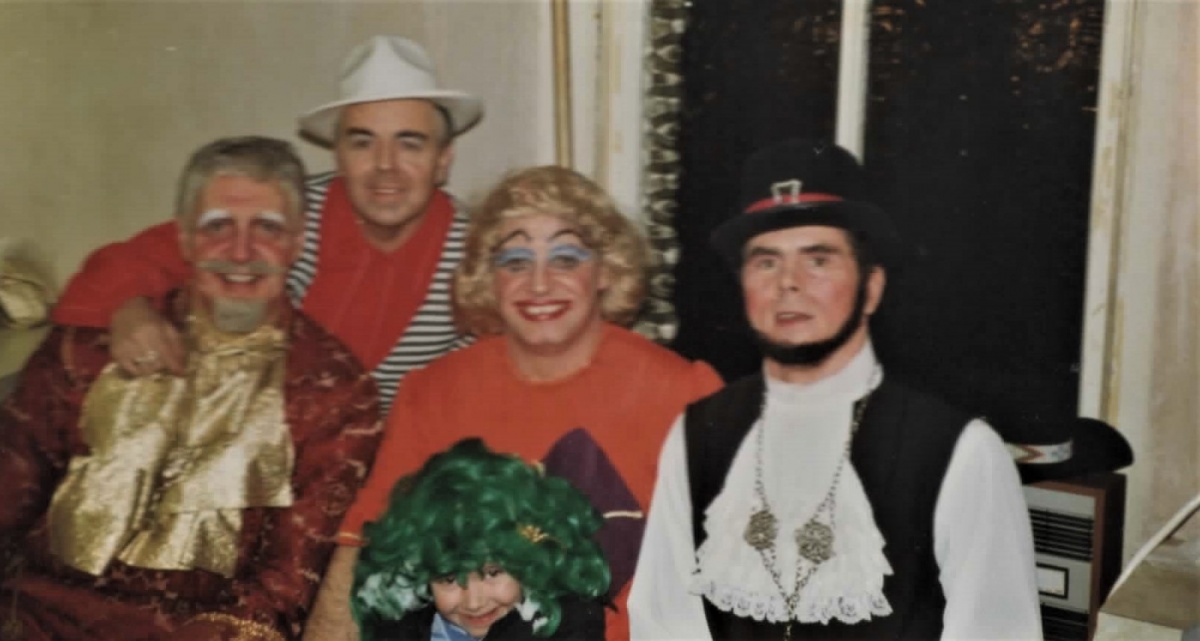
For the 1964 season the same team was in place for The Wizard of Oz. In preparation for this show Fr Daly and James went to London to view the latest West End shows, and to purchase music scores which were not readily available at home. Many of the ideas and special effects which they had seen on stage were to be borrowed for home consumption. Indeed, these visits became part of the preparation for every panto thereafter.
Babes in the Woods in '65 saw the introduction of Dermot Mc Dermott as producer, Michael Mc Williams in a leading role, Paddy Laird as The Dame, a group of Spanish jugglers and a short film by Terence Mc Donald. Fr Daly was certainly not afraid to innovate. The film was a satirical take on a popular television series called "The Man from U.N.C.L.E." Terry Mc Donald's movie was entitled "The Man from Aunt" and it was such a hit with audiences that it was repeated the following year for Dick Whittington and his Cat.
Frank Carson made a very welcome return for just one more season in 1967 with The Sleeping Beauty. By now he was well established on the English circuit, had his own T.V. show and would remain a household name for many years to come. The highly successful run was interrupted by the turbulent political situation which was unfolding on the streets of Derry. As things began to deteriorate it became increasingly more dangerous for both cast and audiences to venture into the city. There was to be just one last panto in The Hall in 1971 - Aladdin - which was produced by Barney Toal.
While Fr Daly's involvement with The Hall would continue for a few years yet, the wonderful entertainment which he had created in that memorable series of pantomimes was never to be repeated.
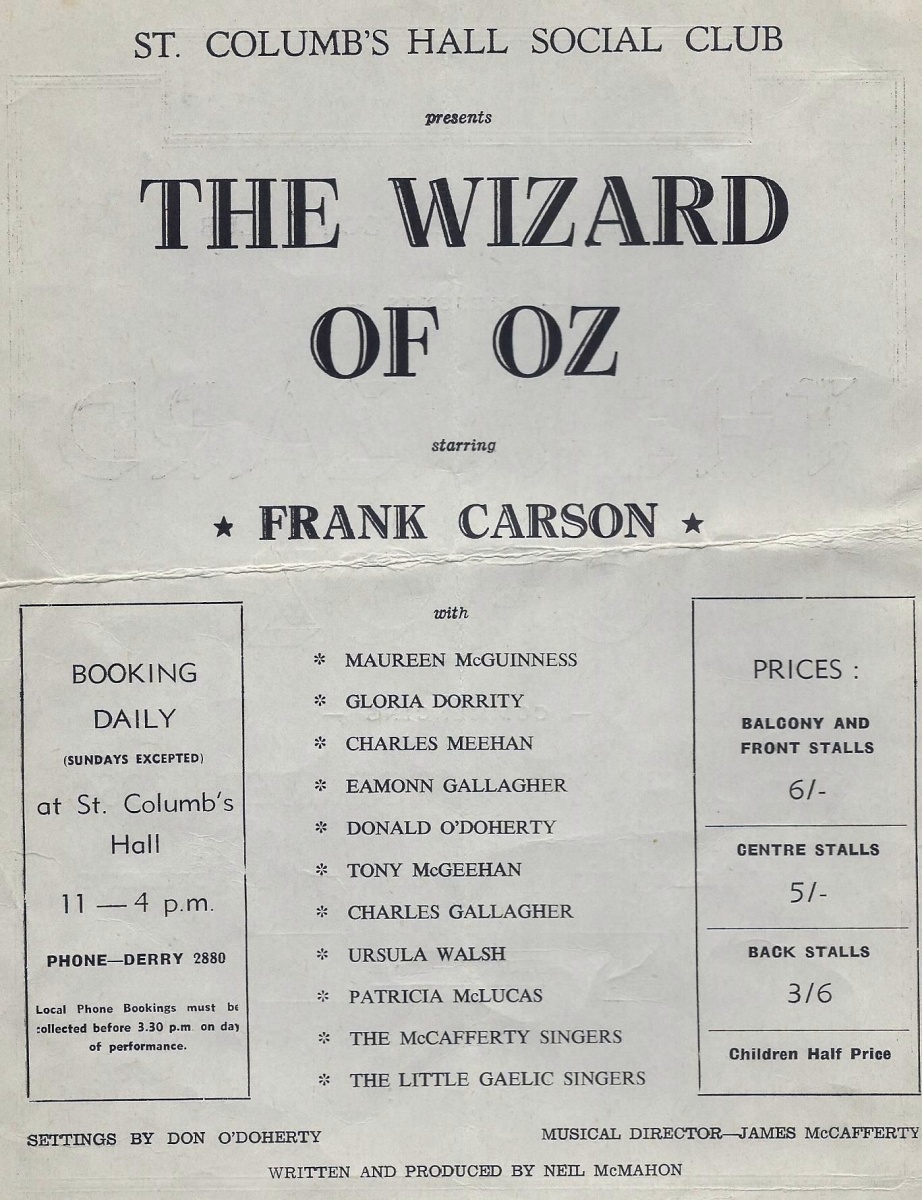 When, at the end of the seventies, Fr. Con Mc Laughlin took over responsibility for the running of “The Hall” he was well aware of his predecessor’s tremendous success in the sixties. ( Father Daly had become Bishop of Derry in 1974 but always his love of St. Columb’s and the theatre remained.) It seemed inevitable that he should set about re-establishing St. Columb’s as the light entertainment Mecca of the north-west. There was a new generation of personalities - especially television performers - who could top the bill for his big variety shows. The same was true for pantomimes. While Frank Carson had gone on to become an international celebrity, there were plenty of comics coming through to take his place. As for the rest of the cast, Derry was coming down with talented young performers just waiting for the call.
When, at the end of the seventies, Fr. Con Mc Laughlin took over responsibility for the running of “The Hall” he was well aware of his predecessor’s tremendous success in the sixties. ( Father Daly had become Bishop of Derry in 1974 but always his love of St. Columb’s and the theatre remained.) It seemed inevitable that he should set about re-establishing St. Columb’s as the light entertainment Mecca of the north-west. There was a new generation of personalities - especially television performers - who could top the bill for his big variety shows. The same was true for pantomimes. While Frank Carson had gone on to become an international celebrity, there were plenty of comics coming through to take his place. As for the rest of the cast, Derry was coming down with talented young performers just waiting for the call.
The production team of James, Mary Mc Laughlin and Don O’ Doherty needed no notice after their run of shows in St. Mary’s. Gene Fitzpatrick filled Carson’s place as lead comic and became very popular with local audiences. Many of the principals and chorus were veterans of Fr. Daly’s and the Creggan pantomimes, and new talents were getting their chance to shine. James’s singing school provided the children’s choruses. His orchestra had already been with him for many of his shows. Mary’s dancing school produced the dancers and the choreography, and Don was ready for comic leads having cut his teeth in the St. Mary’s shows. And so began another season of shows that ran from 1980 until 1985. In some ways it seemed nearly too easy. At first.
The first season or two was greeted enthusiastically enough, but things had changed. Derry was now mostly shunned by the large numbers who in the past had streamed in from Donegal.to make up the audiences. Likewise, the city side was perceived as a no-go area by many who lived on the other side of the river. As well as this many of the local parochial shows had developed a self-confidence and experience in the intervening years and were keen to challenge the previous pre-eminence of St. Columb’s.
But if truth be told, the formula had grown a bit stale and tired. The scripts were mostly reheats of Neil Mc Mahon’s or Jack Cruise’s which had become woefully dated, with, for example, references to “Rinso” washing powder which disappeared in the fifties. The productions had become repetitive and so had some of the music. There was a dearth of original ideas in the production team. That run of pantos came to an unsatisfactory end, a bit like the variety shows, with recriminations and bad feeling. Other production teams and script writers were invited in but sustained success proved elusive for Fr. McLaughlin
Above all, this series of shows coincided with a particularly sad time for James and his family. In September1980 James’s wife, Eileen, died suddenly, and between then and 1985 James’s mother, Cis, his brother, Don, his first cousin, Charlie Meehan and his son-in-law, John Deery, all died along with a host of friends and relations.

